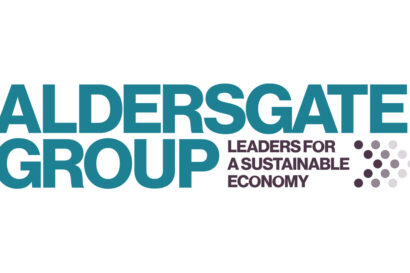AG INSIGHT | 20/11/2025
Running on water: the business case for a cross-economy approach

In this blog, Adam Young reflects the findings of an Aldersgate Group workshop involving our cross-economy membership on water risks and business action.
In July 2025, the Independent Water Commission, led by Sir Jon Cunliffe, made its final recommendations to the government following its review of the water sector regulatory system in England and Wales. At the top of the recommendations is a call for a new, long-term, cross-sectoral and systems-focus strategy. With water issues rising up the corporate agenda, the Aldersgate Group convened a workshop with our cross-economy membership to explore what a more cross-sectoral approach to water could look like. The discussion examined water issues of concern to businesses, barriers hindering progress and the opportunities for collaboration between government, regulators and the wider private sector to resolve challenges.
Water is firmly on the corporate risk radar
Companies are facing pressures from scarcity, pollution and flooding, both domestically and across their global supply chains. Without action to resolve these water risks, growth and investment will become increasingly challenging. The government’s Industrial Strategy and wider growth ambitions depend on sectors reliant on a readily available, resilient and clean water supply, the provision of which is still very much taken for granted.
Water quality is a significant concern, and not just from a public health and environmental perspective. Industrial and agricultural pollution are affecting sectors across the economy, from fisheries and tourism to manufacturing. Meanwhile, water scarcity and flood risk are increasing as the impacts of climate change intensify, and increasing demand is further straining water infrastructure. This poses major challenges for investment and long-term planning in the UK for businesses and high-potential growth sectors that require a stable water environment and increasing supply. A lack of reliable data, fragmented regulation and ageing, inefficient water infrastructure are adding to the concerns of businesses who are looking to mitigate their risks.
Moving from risk assessment to action
The businesses we spoke to are at different stages in their consideration of water:
- Assessment and reporting: Many companies are conducting water audits and integrating flood and scarcity risks into their climate and corporate risk assessments. SMEs are said to be engaging through representative bodies. Taskforce for Climate-related Financial Disclosures and Taskforce for Nature-related Financial Disclosures are driving leadership buy-in and helping firms measure progress against their sustainability targets.
- Engagement: Collaboration and convening are proving valuable. Organisations like WRAP, the Global Reporting Initiative, Aldersgate Group, and regional Landscape Enterprise Networks were cited as spaces for businesses to share knowledge and build water resilience. Information exchange between the finance sector, policymakers and industry is also taking place.
- Investment: From installing water-efficient technologies to supporting nature-based solutions, some businesses are investing in the infrastructure and innovations needed to secure supply and quality. This includes funding for sustainable agriculture and flood management projects in their supply chains.
- Behavioural change: Internal water policies include water efficiency, reuse, and non-potable use. Upskilling and staff engagement are key, helping to embed water stewardship into company culture.
Overcoming barriers
The workshop highlighted barriers that are slowing progress. Systemic barriers include fragmented governance (siloed by sector), lack of good quality data, lack of fiscal incentives and limited water expertise. Crucially, water remains cheap, reducing the incentive for monitoring, conservation or innovation. With a clearer national direction and better coordination between government, regulators and businesses, the UK can unlock potential solutions.
Suggestions for overcoming barriers included:
- A national water data strategy to improve monitoring, verification and transparency
- Stronger regional governance to align water management with local growth and inward investment strategies
- Policy reforms and fiscal incentives to reward efficiency and penalise industrial pollution
- Support for the development of skills to close the corporate water literacy gap
Businesses agreed that leadership from both the public and private sectors will be essential to bridge the “missing middle” between national water targets and localised water use.
Policy innovation
We tested two emerging policy ideas highlighted in the Cunliffe review: extended producer responsibility (EPR) and incentives for pre-pipe solutions.
Extended Producer Responsibility (EPR)
Extended Producer Responsibility was recently introduced for water in the EU under the revised EU Urban Wastewater Directive (2025), whereby producers of pharmaceutical and cosmetic products that contribute towards water pollution contribute towards the costs to remove residues from wastewater. This policy model is based on the polluter pays principle and fair and proportionate burden sharing for environmental harm mitigation.
Participants discussed the potential for EPR to help align business incentives with water stewardship by holding polluters accountable and encouraging investment in water quality and supply resilience. EPR would have potential to accelerate transparency, funding and innovation in water management. Careful consideration would need to be given to the sectors in scope and implementation. For example, smallholders in the agricultural sector would face compliance challenges. A potential risk or unintended consequence would be the re-direction of funds away from nature-based solutions depending on how EPR revenue is reinvested. Businesses who currently fund nature-based solutions as part of their water activities would struggle to make the business case for continued funding in addition to EPR and worry that EPR revenue would focus on infrastructure, resulting in a net loss in investment for nature-based solutions.
Pre-pipe solutions
Measures such as Sustainable Urban Drainage Solutions (SuDS) and nature-based solutions (NbS) focus on preventing pollution and overuse at source, rather than cleaning up after the fact. Demand-side measures can also include water reuse and wetland or peatland restoration. Pre-pipe solutions such as these align neatly with broader climate and biodiversity goals on land and in rivers and could help reduce the long-term infrastructure costs if designed with the right incentives. Clear definitions for pre-pipe solutions and a hierarchy for prioritisation would be needed.
Nature-based solutions are less predictable when compared to engineered solutions, requiring adequate frameworks for good practice and redundancy built into their deployment. For example, a reed bed planted to absorb excess agricultural nutrients will not work 365 days a year, so other solutions are required to complement it. It is likely that any deployment of nature-based solutions would need to be used in tandem with engineered solutions to be effective.
What’s Next?
The overarching message from our workshop was clear: the UK needs a coherent, cross-sectoral strategy for water. Businesses want clarity on the role they can play in achieving national water targets and supporting the sustainable management of the natural resource that is essential for their operations. This includes resilience and ambition for future water supplies.
Regional approaches, backed by strong governance and business engagement avenues, could ensure that water policies reflect the realities of local supply, demand and investment needs.
One participant observed that there are parallels with the energy sector’s progress on strategic planning and coordination, with opportunities for mutual knowledge sharing. Water is a unique resource and requires collective leadership, incentives and accountability. If not planned strategically, water may become a serious threat to the present economy, let alone future growth.



